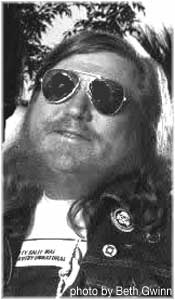
Fellow blogger Brian Murphy has indicated wanting to hear more about the part of my bio that reads: “he broke into the fantasy critical world in the gamer’s magazine Sorceror’s Apprentice, with an essay on Karl Edward Wagner’s Kane which ultimately prompted the author to correct his own previous statements about the character’s chronology.”
So this is for him, and hopefully some others will be interested. Sorceror’s Apprentice #3 (Summer 1979) had the Trout Kane essay (which dealt with the interesting aspects of the character) along with a first stab at the chronology.
This was the story listing, which took the clues from the stories regarding the status of Carsultyal, the Habros Serranthon Empire’s rise and fall, and other clues.
Undertow
Two Suns Setting
BLOODSTONE
The Dark Muse
Sing a Last Song of Valdese
Lynortis Reprise
DARK CRUSADE
Reflections for the Winter of my Soul
Cold Light
Mirage
Raven’s Eyrie
DARKNESS WEAVES
Spacing in time is, of course, wildly varied — sometimes years, sometimes decades, mostly centuries and sometimes many many centuries, but for the most part obscure. There are really only a few that you can nail down.
So, oddly, the first book published is the last Kane novel to read. Karl noted in his remarks that “The Other One” is the last of the short stories, placing it just before DARKNESS WEAVES. I had probably not located a copy of that story yet.
With “Misericorde” four years in the future, obviously it’s not in the list, and I don’t know that I’ve ever tried to place it, though I think Joe Marek or Dale Rippke may have. Both have added on to my work, though I don’t think either of their versions are currently available.
In an afternote to my article, Karl asserted all the story collections were chronological within each book, which would move “Raven’s Eyrie” back to right after “The Dark Muse” and I guess he knew best on that one. But it would also reverse the positions of “Lynortis Reprise” and “Sing a Last Song of Valdese”; which is impossible according to the internal evidence, and I wrote him and told him so and why. So then he remembered that he had preferred to have the closing line of “Valdese” be the closing line of the book, and so had switched them.
In his letter admitting he was wrong, he said my point was “well-made and correct” and he appointed me “Kane Chronologist 1st class, with all privileges and obligations attendant on that rank.” I ran this letter in REHupa #40, but otherwise its been little-known.
John Mayer made a comment a while back on the Wagner Yahoo group that Karl didn’t really want the readers to know the chronology, so they wouldn’t be sure whether Kane would survive a particular adventure or not. Apparently, he never expected anyone to notice the switch.
Brian adds: Thanks for sharing, Steve. You’ve achieved your own small piece of heroic fantasy immortality.






 Sometime in the late 1970s, the Rev. Jonathan Bacon (a one-time member of REHupa) came up with a fairly cool idea. Bacon was the editor of Fantasy Crossroads, a Howard-centric fanzine. Through Glenn Lord, Bacon had acquired the Robert E. Howard fragment, “Genseric’s Fifth-Born Son” (the title derives from Lord, as far as I can ascertain), a part of the “James Allison” series of reincarnation tales. Bacon thought it would be interesting to bring together many of the active fantasy authors at that time and have them “complete” Howard’s fragment in a round-robin fashion. Robert E. Howard himself had participated in something similar when he wrote a chapter for “
Sometime in the late 1970s, the Rev. Jonathan Bacon (a one-time member of REHupa) came up with a fairly cool idea. Bacon was the editor of Fantasy Crossroads, a Howard-centric fanzine. Through Glenn Lord, Bacon had acquired the Robert E. Howard fragment, “Genseric’s Fifth-Born Son” (the title derives from Lord, as far as I can ascertain), a part of the “James Allison” series of reincarnation tales. Bacon thought it would be interesting to bring together many of the active fantasy authors at that time and have them “complete” Howard’s fragment in a round-robin fashion. Robert E. Howard himself had participated in something similar when he wrote a chapter for “ Anthologies of sword-and-sorcery stories have always been thin on the ground. Credit must be given to
Anthologies of sword-and-sorcery stories have always been thin on the ground. Credit must be given to  We live in halcyon days, my friends. Sure, there’s a global “economic downturn” grinding all and sundry ‘neath its leaden wheels and there is a possible influenza pandemic looming (or “lowering,” as REH might say), but we aficionados of the works of Robert E. Howard and John Ronald Reuel Tolkien have much to celebrate in the many coming months, gloom n’ doom notwithstanding.
We live in halcyon days, my friends. Sure, there’s a global “economic downturn” grinding all and sundry ‘neath its leaden wheels and there is a possible influenza pandemic looming (or “lowering,” as REH might say), but we aficionados of the works of Robert E. Howard and John Ronald Reuel Tolkien have much to celebrate in the many coming months, gloom n’ doom notwithstanding.


